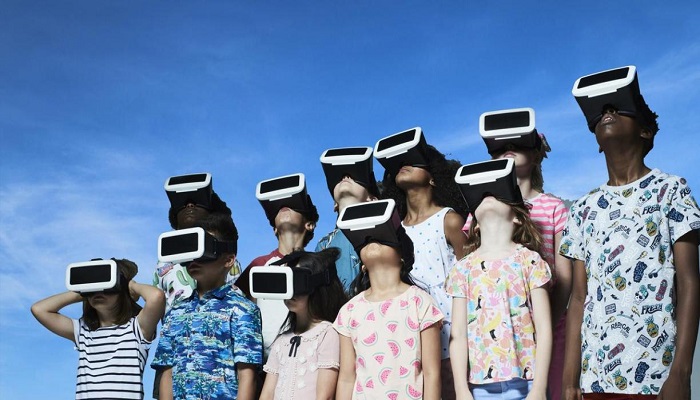Virtual reality is advancing day by day and we’re constantly immersed in it, whether it be for further interpretation of some study fields and contents, observing all their dimensions while forming part of it ourselves. This reality that we wish to observe also occurs when we long to “belong” to different social groups. More and more in the here and now, with technology providing more and more tools to make it happen. With it we can now meet all the needs of wanting to be everywhere at the same time. With the immediacy of technology we’ve become fully immersed, incorporating this choice as the only option.
Technology has advanced and conquered more and more fields faster and faster, thus capturing our attention and awakening our “amazement”, one of the emotional states in which our brain feels fuller and gives us pleasant sensations, generating the hormones of happiness.
Virtual reality is already used in many situations in medicine, engineering and architecture for the implementation of computer tools, such as cases in which it is necessary to interpret plans in the field of construction, while medical studies and practices have acquired greater volume by opting for the advancement of technology.
Moreover, group interaction in the use of virtual games in which all ages have been conquered by the “Belonging” and “Instantaneous” craze. It’s in this area where our brains have been conquered. There’s also been a great innovative upsurge in the recreational field, with 3D and 4D films flooding our lives and enabling us to form part of the interpretative world throughout the film, during which all our senses are brought to the fore. This is the case when we begin to see a thin imaginary thread separating us from the two realities which are not differentiated by our brain.
We enter and leave the virtual world on a permanent basis and feel the need to constantly move into this fictitious space.
Mariano Sigman, an internationally-renowned expert in Neuroscience, relates human behaviour to scientific advances in Neuroscience in decision-making, education and human communication and makes us understand the functioning of our mind, establishing a relationship between lies and the reality of things by asking these questions:
Why does fake news spread faster, further and more widely than real news, in other words, are we more liable to report what’s fake rather than the truth? Why do we do it?
It just so happens that what’s fake isn’t trapped by the limits imposed by “Reality” and, under these circumstances, what’s “Fictitious” can exaggerate the dimensions of the discourse to feed an emotional state, and these are more attractive for our brain.
These devices aren’t restricted to fake news alone, but rather to all the fiction we immerse ourselves in and inhabit. The increased heart rate of someone walking along the edge of a cliff in a virtual reality game is indistinguishable from the real-life experience. And this confuses our body, blurring true and false and reality and fiction.
Sometimes we’re so engrossed in a virtual experience that we almost forget its unreal nature.
From this standpoint I’ll focus on the “Interpretative Risk” that our brain perceives and its parallel reflection in our senses, without neglecting all the cellular functions that display these emotional threats to our body, without being able to differentiate them, confusing our brain, without being able to identify whether it’s one world or another, destabilising our internal functioning and, consequently, our self-regulation and auto-immune system when it comes to facing major challenges.
First we have to control our perception of reality itself; if we don’t understand the reality we experience and interact with on a daily basis, will we be able to become more aware and understand how our senses of perception work and what this entails for the experience itself?
What makes us forget that the virtual world is just an invention?
According to Mavi Sanchez Vives, a doctor in neuroscience and ICREA research professor at the Institute for Biomedical Research at the University of Barcelona, it has been scientifically demonstrated in her virtual reality laboratory that what produces presence isn’t the sensation of “being there”, but rather that of “doing there”. This human experience needs the parallel concept of “being there”, an abstract one that frequently appears in our lives in situations ranging from children’s games to dreams.
Then we’ll understand why fiction doesn’t need to create a world similar to the place we live in.
A broomstick that turns into a horse in a child’s game is just one of the many fables that abound during infancy. The line that separates play and fiction is a thin one.
Mariano Sigman, in his book titled The Power of Words, states that our amphibious desire to alternate fiction and reality has its origin in a fundamental principle, namely our propensity to seek explanations for the unknown. Let’s take a look at a few examples, from abstract concepts to what defines us as social and emotional beings.
One example which may arise is when we take into account stereotypes that we regard as real; when we tend to generalise and build rules based on very few data, there are two main sources of biases and prejudices forming part of the system of intuitions that often lead us to make the wrong decisions while blindly trusting them. Identifying rules based on very few data is an extraordinary feat, so much so that it remains impossible to emulate human cognition in machines and computers, even at the height of the artificial intelligence boom. This form of thinking and the way our brain works provide a way of tingeing reality with fiction.
This particular feature of human thought highlights three ideas:
First of all, I’d like to mention the limitations we face, as we only have access to very partial views of the things that concern us in all walks of life, depending on our concepts of objects, ideas and people.
The second is a virtue that our brain possesses, as it’s fast and efficient in extracting possible rules from limited data. It should be clarified that I say limited because our brain, functionally speaking, first executes the purely emotional reptilian brain before a decision that must also be considered rational; the latter is always slower, and therefore immediacy is the primary choice of our brain and, in this way, it helps us to function without straying into new and unknown worlds. The brain is a guessing machine, it’s almost always right due to the speed with which it draws conclusions, but every now and then it leads us to spectacular failures.
The third is an illusion, not recognising that the brain can lead us to forget that there’s a huge part of the universe that we can’t observe. Our vision is inevitably biased, but we tend to feel and act as if it weren’t more often than not.
In short, one of the most frequent errors when we think is to forget that our considerations are always based on a partial vision, that they affect our way of reasoning, our appreciation of life, our daily life, the beliefs we adopt, the product of our experience, our beliefs and the bonding relationships that mark us with the fire that we inherit, and we draw our thinking and derive our actions from them. Bearing in mind that our eyes, for example, are also limited, as they only capture visible light; there are many waves and bands of light that we can’t see with the naked eye.
To conclude this analysis of virtual reality vs. reality, I’d just like to express the doubt that arises when I think about the thin line of reality, which we interpret on a daily basis, thinking that it’s the pure truth, moving along it with confidence, without realising that each of us are interpretative beings, believing or considering something according to how we look at it.
Will this reality have the same mask as the one we use to immerse ourselves in virtual reality? We move so confidently within it, thinking that what we see and what we explore is pure reality.
Our brain can’t delimit the difference in both reality and fiction and reacts by generating the same emotions, generating the same hormones in both realities, which it considers necessary to address any kind of challenge, such as adrenaline in cases of stress, or serotonin, endorphins, dopamine and oxytocin in cases of happiness.
Source: Telefónica



